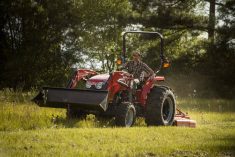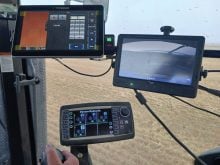St. Louis, Mo. — Similar to how custom harvest operations travel across North America following crops as they ripen, fleets of robot planters will follow favourable planting conditions in the spring, if the business plan of Sabanto Ag gets traction.
The company is managed by Craig Rupp and Kyler Laird, who met at an agBOT challenge in 2017.
“Craig and I were talking about automation. I kept telling him about my experiences and where I was seeing these benefits. We kept saying, someone is going to automate this,” Laird said during his presentation at InfoAg in St. Louis, Missouri.
Read Also

Growing garlic by the thousands in Manitoba
Grower holds a planting party day every fall as a crowd gathers to help put 28,000 plants, and sometimes more, into theground
“It was easy to come up with a list of who is not going to do this, but it wasn’t easy to come up with a list of who was going to do it.”
The two decided to put their expertise together to found Sabanto Ag, which they described as a farming-as-a-service company performing row-crop operations using advanced autonomous equipment.
Laird has been tinkering with his farm equipment and turning them into autonomous platforms since 2015, when got his John Deere 420 lawn tractor to work autonomously.
“This was my hardest one. I had to pull all the electrical systems and hydraulic systems. I made my own hydraulic lines. It was a big project,” Laird said.
After getting a taste for automation he wanted an autonomous tractor that can perform field work, so he pulled his grandfather’s old Massey Ferguson 2745 out of the shed.
He said it’s is a very simple tractor, but he was able to get it up and running and by the end of the 2016 season it drilled 50 acres of beans beside his house.
“It didn’t go fast, which was perfectly fine. It had a hard time maintaining a straight line. But I found out literally with a few hundred dollars’ worth of equipment, I could automate,” Laird said.
He then traded off one of his new tractors and bought an older Challenger MT765 and installed autonomous technology into it.
He programmed it to pull his grain cart
“At first it was remote control. Then it got to the point where I could set it for a straight line,” Laird said.
“It would do a straight line by the combine and I could bump it over one way or the other. So as I was filling it, I could bump it back and forth. This was huge,” Laird said.
Once the cart was full Laird would remotely drive the tractor to the edge of the field, where truck drivers would take over control to load up.
The drivers would then place the system back on automatic so Laird could again take over control.
Laird then installed autonomous technology in a 100 horsepower John Deere 6330, and fitted it with a three-point hitch eight-row 7300 planter, and a fertilizer tank on the front end loader.
“I had a lot of five- and 10-acre days there for a while in 2017. And then it got good, and then it got going. This did 535 acres, all of my corn for that year. I was never on it when it was planting,” Laird said.
He said by the end of the season planting became very boring.
But this wasn’t a bad thing because he was able to concentrate on keeping ahead with tending fertilizer, seed, and digging into the rows to make sure the seed was being properly placed.
“There was always something to do, but I didn’t have to be on the tractor,” Laird said.
“There is no need for a cab, no need for air conditioning, there’s no suspension or XM (radio subscription). This started to feel very efficient. I like this tractor a lot,” Laird said.
In 2018, he had two robot tractors plant his crop — his John Deere 7300 and his Challenger, which was outfitted with his next generation of autonomous control and an eight-row planter.
He said the Challenger is much more graceful than the 7300 because it can handle curves and is programmed to turn around gradually, which is important because tracks can make a mess of the field.
“I had two eight-rows, so I’m back to 16 rows, which is what I was planting with before. I probably have less money in these two than I had in my bigger one, and I don’t have to sit in it,” Laird said.
“I don’t have to hire someone to run a seed tender, to run the fertilizer trailer. I don’t have that expense, and I can keep track of stuff. This felt very powerful.”
For the 2019 planting season, Laird teamed up with Rupp and established Sabanto Ag.
Rupp is an electrical engineer with extensive experience working on guidance systems.
The newest robot seeder, a JCB Fastrac tractor with an 18-row planter, can be loaded on a standard single-drop semi tractor-trailer.
Laird said the company wants to move planting capacity around very easily, so it can help growers plant on very short notice.
“We can put this on a trailer and can be almost anywhere overnight. So that changes things if we have a fleet of these,” Laird said.
“If you’re dry and ready to go tomorrow, wouldn’t you love to have five or 10 of these show up and do maybe 500 aces in a day, maybe ideally in big fields? That’s a really good way to handle these rough-weather, challenging seasons.”
Planting conditions in 2019 were terrible in wide swaths of United States’ growing regions, but the company was able to work through issues of equipment set-up, software, and connectivity.
“We went to Iowa, Nebraska, back to Iowa, Minnesota, Illinois, and back home and did my acres in Indiana. Our goal, we thought if we get the whole season we could do 10,000 acres. This was not the season to get 10,000 acres,” Laird said.
Even though Laird didn’t meet his goal of planting 10,000 acres using autonomous equipment in one year, he likely did reach a new record of the most aces planted by someone watching his robot while sitting in an RV.


















